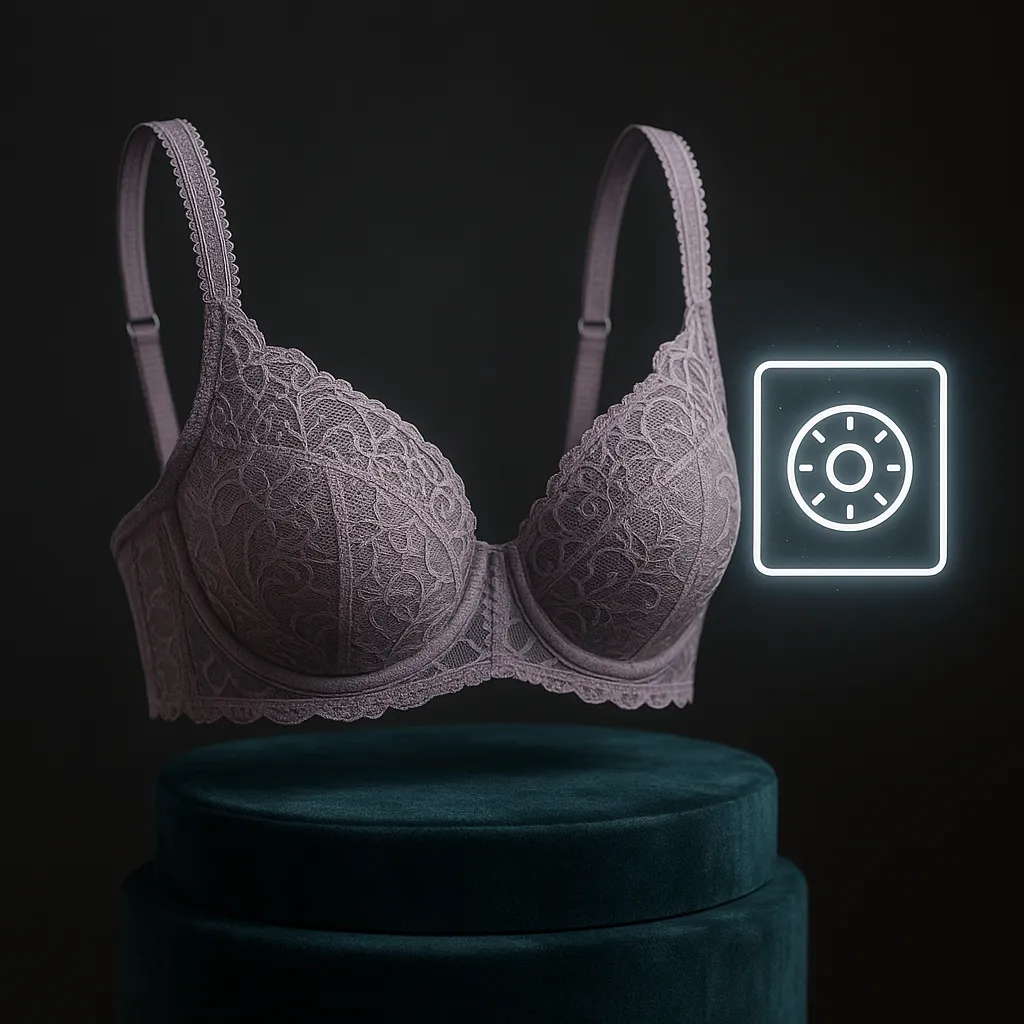
From Hollywood to the Closet: Famous Bras in Pop Culture
Last in series: Week 4 - The Bra as a Cultural Artifact
Don’t miss any stories from our September lineup! Explore all the posts in this month’s series, from collectors to models, and see how every intimate item has a story to tell.
Introduction
Some bras are remembered not because of how they fit, but because of how they fit into culture. Hollywood has long known the power of lingerie, and music icons have wielded bras as costumes, statements, and even weapons of rebellion. Last week, we spoke about bras as cultural artifacts; this week we zoom in further—into the bras that leapt from the screen and stage into our collective imagination. From Marilyn Monroe’s satin shapes to Madonna’s cone bra, these are the bras that left the closet and became symbols of a moment.
Hollywood’s Lingerie Icons

Hollywood has always known that what a character wears beneath the surface can shape a scene. In the 1940s and ’50s, stars like Jane Russell and Marilyn Monroe embodied glamour and sensuality in lingerie that pushed boundaries of the day. Bras in film were rarely just undergarments—they were storytelling tools.
Russell’s wardrobe in The Outlaw (1943) brought the structured bullet bra into the limelight, blending engineering with allure. Monroe’s costumes often paired plunging necklines with supportive designs that gave her signature silhouette. These bras became cultural shorthand for confidence, sexuality, and femininity, cementing themselves in history far beyond the movie posters.
From Silver Screen Glamour to Cult Icon: Enter Chesty Morgan

While Marilyn Monroe and Jane Russell epitomized the glamorous, hourglass ideal of mid-century Hollywood, Chesty Morgan introduced a more provocative, boundary-pushing presence to the screen. Born Liliana Wilczkowska in 1937, Morgan gained fame as a burlesque dancer and later starred in two cult-classic exploitation films directed by Doris Wishman: Deadly Weapons and Double Agent 73 Wikipedia. In these films, her character's 73-inch bust was not just a physical attribute but a central plot device—emphasizing how bras and lingerie can transcend utility to become symbols of power, identity, and spectacle.
Morgan's performances were marked by a slow, deliberate striptease that emphasized anticipation and theatricality, aligning with the burlesque tradition of teasing rather than revealing. Her films, though often campy and over-the-top, challenged conventional notions of femininity and sexuality, positioning lingerie as a tool of empowerment and subversion.
Music, Stage, and the Performance Bra
If film glamorized bras, music turned them into weapons of cultural disruption. Madonna’s 1990 Jean Paul Gaultier cone bra didn’t just reference lingerie history—it exploded it. The pointed silhouette mocked modesty, flaunted power, and became a global conversation starter.
But Madonna wasn’t alone. Decades earlier, Jean Harlow made lingerie a spectacle in the 1930s, her satin slips and bras setting Hollywood’s standard for allure. In the 1960s, Raquel Welch’s on-screen costumes fused fantasy and sensuality, cementing the bra as a cultural signifier. Later, the spectacle grew louder: Britney Spears’ schoolgirl-inspired bra-and-shirt combo at the 1999 MTV VMAs became instantly iconic, while Janet Jackson’s 2004 Super Bowl “wardrobe malfunction” ignited worldwide debates on exposure and modesty.
Jean Harlow (1930s): Often credited with popularizing the bra as a visible fashion element in films, with satin slips and lingerie scenes that set trends.
Raquel Welch (1960s/70s): Her iconic roles frequently leaned on bras and costumes that blended fantasy with sensuality, influencing both fashion and collectors.
Britney Spears (1999 MTV VMAs, “...Baby One More Time”): Schoolgirl-inspired outfit with bra peeking through—an instantly recognizable pop culture moment.
Janet Jackson (2004 Super Bowl “wardrobe malfunction”): A controversial yet unforgettable pop culture event that thrust bras (and their absence) into a global conversation.
Katy Perry (2010s): Known for whimsical performance bras—whipped cream canisters, candy motifs—turning bras into playful props.
Lady Gaga (beyond the pyrotechnic bra): Meat dress overshadowed, but her bras often carried avant-garde or political messaging.
Victoria’s Secret “Fantasy Bras”: Multi-million-dollar, jewel-encrusted runway bras worn by supermodels like Heidi Klum, Gisele Bündchen, and Tyra Banks.
Pop stars leaned into bras as props as well—Katy Perry wore whimsical candy and whipped-cream bras, while Lady Gaga’s creations ranged from avant-garde leather to bras that literally sparked flames. And on fashion’s grandest stage, Victoria’s Secret “Fantasy Bras,” dripping in jewels and worn by supermodels like Gisele Bündchen and Tyra Banks, turned lingerie into million-dollar art pieces.
Each of these moments pushed bras beyond fabric and wire, transforming them into performance symbols. Collectors often prize memorabilia tied to these cultural flashes, hunting for replicas, promotional tie-ins, or authenticated pieces linked to unforgettable stages and screens.
Celebrity Endorsements and Designer Collaborations

When celebrities move from wearing bras to designing them, the cultural influence deepens. Rihanna’s Savage X Fenty revolutionized lingerie by merging inclusivity, bold styling, and performance spectacle. Victoria’s Secret models, too, made their bras iconic by association, parading “Fantasy Bras” encrusted with jewels and broadcast globally.
These collaborations remind us that the bra is as much fashion statement as functional piece. Limited editions, runway exclusives, and celebrity campaigns not only drive retail spikes but also leave lasting impressions that ripple into collector markets.
Bras as Storytelling Devices

A bra in pop culture is rarely just a garment—it’s a storytelling device, capable of symbolizing transformation, identity, vulnerability, and even humor. In film, bras can mark a coming-of-age moment, a rebellion, or a punchline. Take Weird Science: the four boys with bras on their heads are more than a gag—they’re engaging in narrative play, using lingerie to subvert expectations and generate comedy.
Robert Downey Jr., who grew up appreciating the absurdity and nuance of storytelling, has carried that sensibility into his roles—most famously as Tony Stark. Stark embodies wit, ingenuity, and a collector’s mindset: he values artifacts, technology, and history, curating them carefully while building his own narrative. Just as a bra can shape perception and expectation, Stark’s Iron Man suit transforms him, visually and narratively, into something greater than the sum of its parts.
Collectors, then, are not just preserving fabric—they are curating the narratives that accompany it, honoring moments of humor, empowerment, or transformation that resonate far beyond the screen. A bra can be a costume, a symbol, a prop, or even a punchline, but in each instance, it tells a story worth remembering—making Tony Stark, in many ways, the ideal collector archetype.
The Collector’s Eye: From Pop Culture to Private Collections
The journey from stage spotlight to private collection is a delicate one. Authenticating, preserving, and documenting these pieces is no small feat. Provenance matters: Was it truly worn by the star? Was it a stage prop, a replica, a promotional giveaway?
Collectors often invest as much in the story as in the bra itself. A plain bra becomes extraordinary if it was linked to a famous photo shoot or televised moment. The allure is not in the stitches alone but in the memory stitched into them.
Looking Forward: Pop Culture and Collectability
As culture continues to accelerate through streaming, social media, and digital fandoms, what becomes iconic evolves quickly. A bra worn during a viral performance today may become tomorrow’s collector’s treasure. The line between physical and digital is blurring—NFTs, digital twins, and metadata could one day ensure the provenance of bras worn in iconic moments.
Bratags’ role is to bridge this gap. By cataloging, preserving, and sharing stories tied to bras, the platform helps ensure that what begins as pop culture does not fade, but becomes culture worth collecting.
Conclusion
From Hollywood glamour to arena stages, famous bras have shaped how we see beauty, power, and identity. They are cultural artifacts wrapped in lace and satin, symbols of performance and personality.
Which bras shaped your imagination? Was it a movie scene, a music video, a fashion campaign? Share your stories—we want to hear how pop culture bras entered your memory and perhaps your collection.
Next week, we’ll turn the lens toward the psychology of collecting itself: why intimate objects spark such powerful emotional connections.
Create your Bratags account and come along for the ride—30 stories, one for each day.
- List your bras Signup Now
- Join our mailing list
- Pitch us your data questions or ideas [email protected]



















































